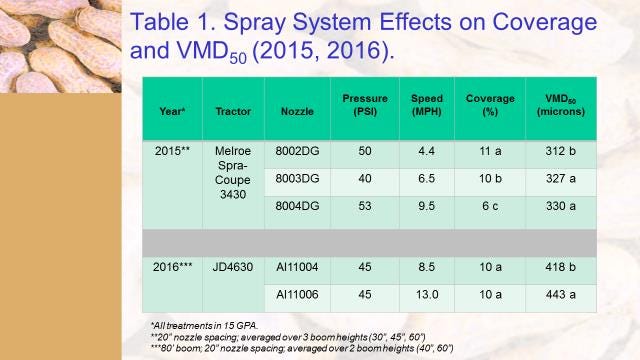
Clearing up the controversy over sprayer speed and herbicide coverage
Tractor speed, GPA, nozzle type, pressure, boom height, and chemicals applied are all interacting to partially determine the effectiveness of herbicide applications. Herbicide rate, timing and environmental conditions before and after application are also very critical.
March 17, 2017

“Fast and ready sets the pace, but slow and steady wins the race,” my sage father said to me when I was a young boy struggling with my fledgling athletic skills and frustrations with playing time. As always, he was right. After you read this article, perhaps this saying will have new meaning for you.
After headlining the county production meeting circuit this spring, it has come to my attention from my colleagues and regular column readers that there seems to be some controversy over a previous article that I wrote back in the fall of 2016. Specifically, my Nov. 8 Tailgate Talk article, which touched upon some new research about tractor speed and boom height. It raised some eyebrows. I will try to do a better job in this article explaining what I think this and other data suggests.
Before I go any further, I want to make it absolutely clear that in no way, shape or form am I suggesting that faster application speeds and excessively high boom heights are the way to go! It is much more complicated than that. Tractor speed, GPA, nozzle type, pressure, boom height, and chemicals applied are all interacting to partially determine the effectiveness of herbicide applications. Herbicide rate, timing, and environmental conditions before and after application are also very critical.
Let’s revisit the data that I, along with the assistance of UGA agricultural engineer extraordinaire Dr. Glen Rains, have collected over the last 2 years (Table 1). You will note in 2015 that when water was applied with a spray system that produced medium size droplets (312-330 microns), that increasing tractor speed from 4.5 to 9.5 MPH resulted in a 45 percent decrease in spray coverage. This same negative trend was not observed in 2016 when a spray system that produced very coarse droplets (418-443 microns) was used.
Now let’s use this data to assess what could potentially happen if spraying a contact herbicide such as Liberty (glufosinate). If the 2015 spray system was used, it is very likely that weed control with Liberty would have been reduced when applied at 9.5 MPH because spray coverage was decreased.
In 2016, this spray system would not have been a great choice to apply Liberty, at any speed, because droplet size was not optimum. Preferred droplet sizes for Liberty would generally be in the medium range category (~250- 350 microns). As you can see, this makes a spray system recommendation that is suitable for all situations rather difficult.
Another thing to consider when assessing your “need for speed” is how it can potentially influence physical drift. In one study, increasing tractor speed from 3.7 MPH to 7.5 MPH resulted in a 1.3X to 3.9X increase in drift depending upon the nozzle type used. In another study, increasing speed from 4.4 MPH to 6.2 MPH resulted in a 90 percent increase in drift.
Recent research in Georgia, using nozzles designed to minimize drift potential, indicated that herbicides applied at 10 MPH to 13 MPH by a Jedi-skilled applicator drifted much more than was anticipated. Kind of an important issue in today’s era of auxin-tolerant crops!
I welcome any and all comments, good or bad, about the popular press articles that I write. I have always prided myself on being an Extension specialist who responds to the needs of his clients, especially county Extension agents and growers. If you are spraying herbicides at warp speeds, having good success, and not drifting on your neighbor, throw this article and the other two articles I have written about tractor speed in the circular file.
However, if you are not quite getting the weed control that you want and are concerned about drift, consider slowing down. You might also want to consider using a spray system designed to produce droplet sizes that are optimal for the herbicide(s) applied. Adopters of the new auxin-tolerant crop technologies will have specific labeled restrictions on nozzle type, ground speed, and boom height. Lastly, remember the words of my wise old man “fast and ready sets the pace but slow and steady wins the race!”
As always, good weed hunting!
About the Author(s)
You May Also Like





